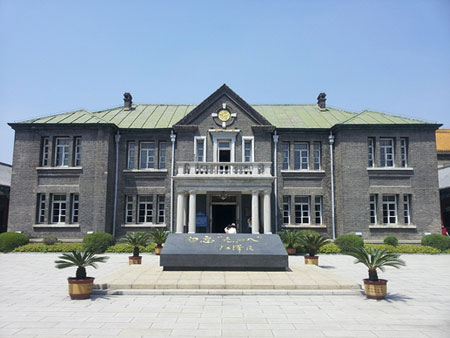The Manchukou, or State of Manchuria, was a puppet state in Northeast China crossing into Inner Mongolia and was ruled under constitutional monarchy. Although the government was abolished in 1945, following the Japanese defeat, Changchun’s architecture and history still boasts this rich past. These historical sites are worth a visit as they are a great representation of Emperor Puyi, the last emperor of China, and his legacy.

Source: Kilian Evang
1) Puppet Imperial Palace
The Puppet Imperial Palace is where the last emperor of the Qing Dynasty, Aixinjueluo Puyi, lived when he was acting emperor of the Manchus, and is one of the three big palaces in China. Puyi the Emperor lived here between 1932 and 1945.
The building is a great representation of Chinese palace architecture, and the new body is built using brick and iron into a two-story European style building with relatively simple styles, a race course, flower garden and an air-raid shelter.
The palace comprises 200,000 square meters of land, including displays of pictures, artifacts, pictures and other information (in Chinese and English). This gives a good overview of everyday life under Japanese colonial rule, and helps in understanding Chinese history as a whole.
There are audio tour handsets available for 10 RMB with a 100 RMB deposit.
Add: 5 Guangsha Beilu, Kuancheng District, Changchun
地址:长春市宽城区广厦北路5号
Tel: 0431 8286 6611
Price: 30 RMB (students); 80 RMB
Opening Hours: High season (May 1-October 7) 08:30-17:20; Low season (October 8-April 30) 08:30-16:50
1) The Former Site of Manchukuo State Department
The Former Site of Manchukuo State Department was established in 1933, and was the main government building during the puppet empire, used for Japanese government services.
There are a total of five buildings that make up the main building, all covered in brown glazed tiles, modeled on Japanese parliament buildings.
The most worthy of visiting inside the site is the parade observation platform, Manchukuo State Prime Minister Zhang Jinghui’s office, a gallery, an exhibition of human body specimens, and uniforms that are on display.
There are audio tour handsets available. These machines have a 100 RMB deposit and a 10 RMB rental fee for an unlimited period of time, and include an English language option.
Add: 2 Xinmin Dajie, Chaoyang District, Changchun
地址:长春市潮阳区新民大街2号
Tel: 0431 8286 8516
Price: 10 RMB
Opening Hours: 08:00-18:00
Getting There: take bus 264 or 276 and get off at Jida Yiyuan stop (吉大一院).
1) Former Site of 8 Manchukuo Puppet Buildings
Xinmin Dajie (新民大街) can be said to be the street on Changchun with the most Manchukuo architecture, and the eight old sites of the government are all on this road. This includes the Sheriff’s Department, the Ministry of Justice, the Ministry of Economic Affairs, the Ministry of Transportation, the Ministry of Agriculture, the Ministry of Foreign Affairs, and the Ministry of Health.
The Sheriff’s Department, Ministry of Justice, Ministry of Economic Affairs and the Ministry of Transportation are all next to each other; on numbers 1, 6, 5, and 7 Xinmin Dajie. These buildings were built in 1936, and are all in different architectural styles. Some take a more European exterior, while others have a more classic Japanese look. At the moment, the Norman Bethune University of Medical Science is placed inside these buildings and you need a permit to enter the premises. The nighttime view here is definitely worth it. Here are the addresses of the other buildings;
The Ministry of Agriculture
Add: 20 Ziyou Dalu, Chaoyang District, Changchun
地址:长春市潮阳区自由大路20号
Ministry of Education
Add: 18Ziyou Dalu, Chaoyang District, Changchun
地址:长春市潮阳区自由大路18号
Ministry of Foreign Affairs
Add: 1 Puqing Hutong, Chaoyang District, Changchun
地址:长春市潮阳区普庆胡同1号
Ministry of Health (currently a school, can only view from outside)
Add: 77 Renmin Dajie, Chaoyang District, Changchun
地址:长春市潮阳区人民大街77号
Warning:The use of any news and articles published on eChinacities.com without written permission from eChinacities.com constitutes copyright infringement, and legal action can be taken.
Keywords: Puppet Imperial Palace Manchukuo Changchun Architecture History
All comments are subject to moderation by eChinacities.com staff. Because we wish to encourage healthy and productive dialogue we ask that all comments remain polite, free of profanity or name calling, and relevant to the original post and subsequent discussion. Comments will not be deleted because of the viewpoints they express, only if the mode of expression itself is inappropriate.
Please login to add a comment. Click here to login immediately.
Yes, this is a nice museum and gives a good insight in the Japanese period of Changchun. The adjacent war museum is chilling and disturbing and displays some of the atrocities committed by the Japanese during their occupation. I can understand why there is little love lost for Japanese in this area.
Nov 03, 2014 01:30 Report Abuse
It's a nice museum indeed and gives some cool insight into the history of Changchun. The war museum is pretty disturbing and is a testament to both the cruelty of the Japanese during the war and the inability of the Chinese to move on (I'm thinking of the writing about the Chinese traitors during the war describing their "ugly looks" etc.).
Nov 03, 2014 10:53 Report Abuse